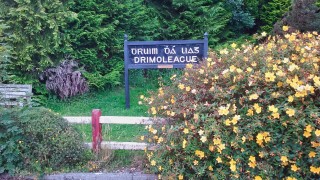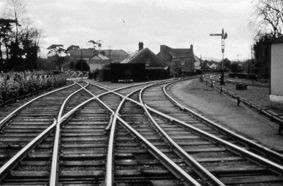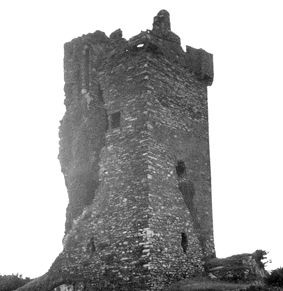
Drimoleague
A large sign on the approach to Drimoleague describes the village as being the Heart of West Cork. The distinctiveness that causes West Cork to be known as ‘a place apart’ can be found here in full blossom, yet it remains largely undiscovered by the average visitor, who prefers to keep nearer to the coast.

Directions
Located on the R586, about 70km west of Cork city, and almost equidistant by 12km each, from the busy market towns of Bantry, Skibbereen and Dunmanway.
Here at the heart is to be found rich folklore, warm friendliness, down-to-earth faith, lively cultural expressions and a varied and interesting history going back to St Finbarr of the 6th century and beyond. Here also is a landscape of remarkable beauty, comprising mountains, undulating farmland, pristine riverbank, woodland and a largely unspoiled flora and fauna.
Drimoleague is found in the River Ilen basin, and its main street stretches out alongside one of its fast flowing tributaries, the Ruagach. Its location formed the natural junction for the Bantry and Skibbereen branches of the West Cork Railway, whose arrival here in 1880 transformed a scattered hamlet into a thriving village.
The village is a strong community, proud of its past and welcoming to newcomers. Each house in the village bears its own legend of unforgotten characters and well-rehearsed folklore.
The village has much to offer the visitor. There are a number of guesthouses, bars, a restaurant, a take-away and a modern convenience store. There is a splendid GAA pitch, and a fine pitch-and-putt course, which is immaculately kept by a local committee. The basketball and tennis courts have been recently refurbished and the children’s playground is modern and well maintained.
Drimoleague information courtesy of www.drimoleaguewalkway.com
VILLAGES NEARBY: Caheragh
The village of Caheragh is situated at the very heart of West Cork. This mostly rural parish lies between Drimoleague and Ballydehob and between Skibbereen and Bantry and is known as Ireland’s second largest parish.
Among the many ancient sites in this district, there is a vast number of burial grounds, most of them for children. There is also a holy well at Tooreen called Tobareen na bhFaithne which had curative powers for warts.
Caheragh church site was anciently called Tigh Br thar na Cathrach but there are no traces of the building, no names of friars and no saint to whose honour the supposed foundation was made. The medieval church of Caheragh was dedicated to the Blessed Virgin, but it was in Protestant hands by 1639, and in 1699: there was no church. The present church of the Holy Family was built in the 1960s.
History
All around the village of Drimoleague are reminders of its heritage: Beamish’s corn mills; three distinctive churches; and an old railway station which is preserved almost intact since the sad demise of the rail system in 1961. The archaeological map of the parish is dotted with standing stones, ring-forts, fulachtaí fia, and holy wells.
For a comprehensive history of the village and surrounding area you should purchase ‘A guide to Drimoleague Heritage Walkways’ from local shops. This beautifully illustrated book gives the background behind the sights, sounds and characters of Drimoleague.
Railway
Drimoleague was a major junction where the Cork line split, with trains going onward to either Bantry or Skibbereen. Drimoleague itself possessed the largest signal cabin — with 31 levers — in the West Cork system. There were three passenger platforms in Drimoleague. In comparison, Skibbereen and Bantry only had one each, while Dunmanway had two.

The neat and tidy station was a hive of activity, with butter, cattle, sand and all kinds of provisions being loaded and unloaded.
Up to 35 people were employed at the height of the railway era. They included porters, signalmen, firemen, cleaners etc. The old railway station was converted to become a textile factory in the 1970s, which has now also closed. As you ascend the steps you see the remains of the old engine house on your left.
Barr Na Carraige
Beyond the village to the north is Barr na Carraige (Top of the Rock), the old village of Drimoleague, rich in history and verse. It is said that Saint Finbarr visited Barr na Carraige in the 6th century, when according to tradition, he admonished the people to turn to Christ, and then went on his way to Gougane Barra. A long tradition of pilgrimage from Drimoleague to Gougane Barra continued until the middle of the last century.

There were some 36 houses here and on the roads leading up to it, according to an 1841 map. This road was once the main road from Cork to Bantry, along which armies travelled. A large stone westward from here is said to mark the spot where a Cromwellian soldier died and was buried by the wayside. Another tradition has it that it was a soldier from the ill-fated French Armada Force.
In 1847 the famine halved the population of the Top of the Rock. Jeremiah O’Donovan Rossa, the great Fenian champion of Irish freedom gave a rousing speech here in 1864 and put a top to the bloody faction fights for which the Top of the Rock was famous.
Castledonovan
North of Drimoleague is the ancient stronghold of Castledonovan, which is presently undergoing preservation works. Castledonovan or O’Donovan’s Castle refer to the remains of an Irish tower house or túrtheach of medium size which was the so-called “seat” of the Clann Cathail of the O’Donovans for a period during the 16th century.
The original name of the castle, and when the O’Donovans were actually living in it, was Sowagh before the 17th century. The name of Castle Donovan is associated with a regrant from James II of England in 1615.

Approximately 60 feet in height, it sits on an enormous rock or outcropping, which forms the ground floor, close to the bank of the River Ilen. It is commonly believed to have been built, or at the very least augmented, by Donal of the Hides, Lord of Clancahill from about 1560 to his death 1584. His son Donal II O’Donovan then repaired or further altered the structure some decades later, but was not living in it by then. It is believed that his father had already relocated the family in the first decade of that century to the more profitable Rahine Manor on the seacoast to protect their maritime interests.
According to tradition the tower was severely damaged by Oliver Cromwell’s soldiers in the late 1640s, blown up in retaliation for Donal III O’Donovan joining the Stuart side and for his involvement in the rebellion and massacres of 1641, and has been uninhabited since that time.
The tower’s surrounding wall or bawn and outbuildings are long gone, but over two thirds of the tower still remain. The explosion left only a small gouge in the southwest corner, but caused huge cracks in the masonry, leaving the structure unsafe, and over two centuries later the entire western wall, excluding the still intact spiral staircase, and majority of the southern wall collapsed. It is currently undergoing conservation.
Things to do
Fishing & Angling
For anglers, the River Ilen is a well-known Atlantic Salmon and Sea Trout river with spring and autumn runs of fish from the sea upstream. There are a number of well-stocked trout fishing lakes within five miles of the village.
Walking
Drimoleague, which was once the busiest railway junction in West Cork with no fewer than three platforms, has now become the hub of walking networks in the area. Hence the title, The Walker’s Junction of West Cork. Here the acclaimed Sheep’s Head Way converges with the five Drimoleague Heritage Walkways, and then continues northwards to Kealkill. St Finbarr’s Pilgrim Way, a 37km ancient pilgrim path to St Finbarr’s hermitage at Gougane Barra, also starts here. See The Drimoleague Heritage Walkways section under the Walking section.
The Drimoleague Walkways committee invite visitors to join them to walk the 34 km from the Top of the Rock, Drimoleague to St Finbarr’s hermitage at Gougane Barra during August each year. This is a contemplative walk, exploring the spirituality of St Finbarr, and so drawing strength for life’s journey. The spectacular scenery and the rootedness in tradition come together to make this a truly West Cork “camino” experience. To find this year’s dates and book a place contact David Ross on 086 1735134.
